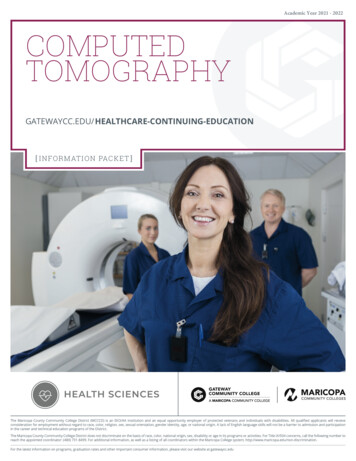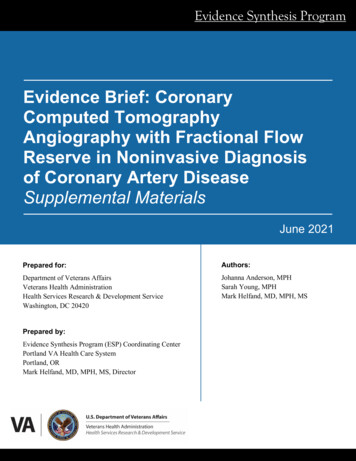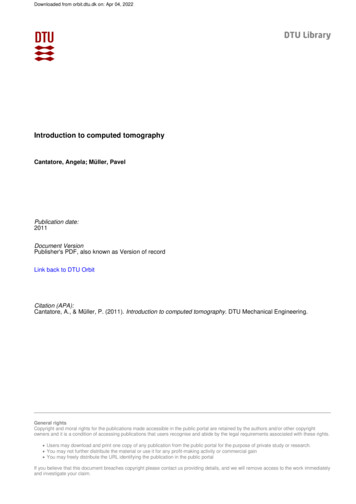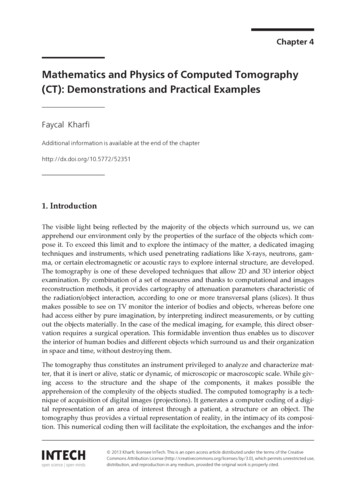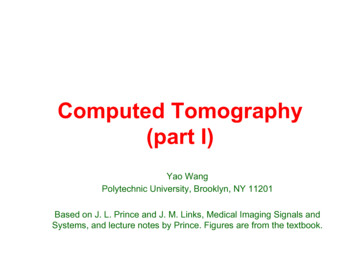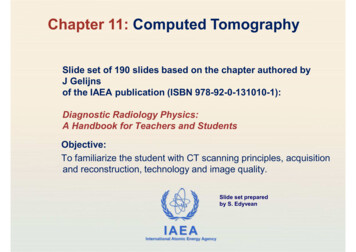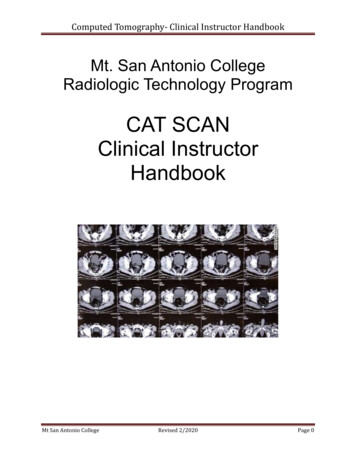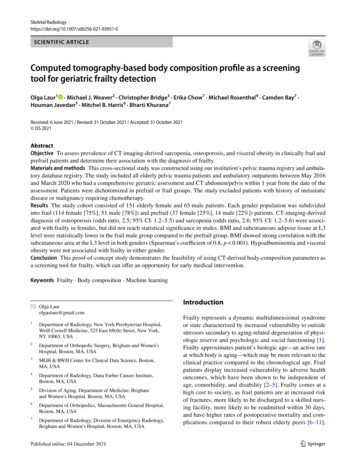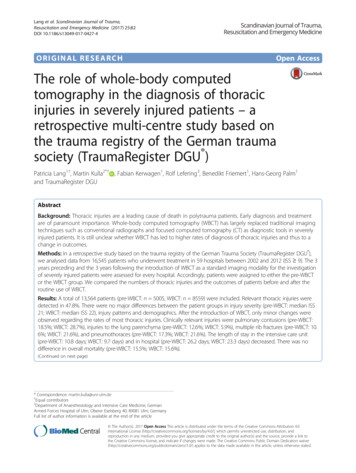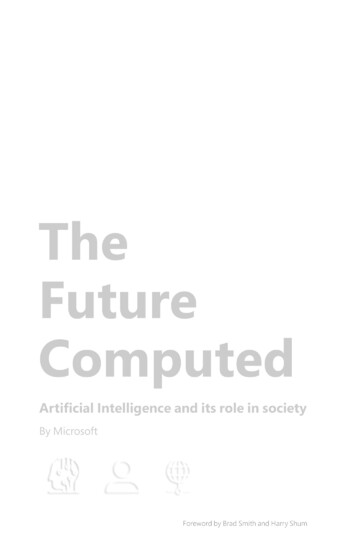
Transcription
TheFutureComputedArtificial Intelligenceand its role in society
Twenty years ago, we both worked at Microsoft, but onopposite sides of the globe. In 1998, one of us was living andworking in China as a founding member of the MicrosoftResearch Asia lab in Beijing. Five thousand miles away, theother was based at the company’s headquarters, just outsideof Seattle, leading the international legal and corporateaffairs team. While we lived on separate continents and inquite different cultures, we shared a common workplaceexperience within Microsoft, albeit with differing routinesbefore we arrived at the office.ForewordThe FutureComputedBy Brad Smith and Harry Shum2The FutureComputedAt that time in the United States, waking to the scent ofbrewing coffee was a small victory in technology automation.It meant that you had remembered to set the timer on theprogrammable coffee maker the night before. As you drankthat first cup of coffee, you typically watched the morningnews on a standard television or turned the pages of thelocal newspaper to learn what had happened while you slept.For many people a daily diary was your lifeline, remindingyou of the coming day’s activities: a morning meeting at theoffice, dial-in numbers and passcodes for conference calls,the address for your afternoon doctor’s appointment, anda list of to-dos including programming the VCR to recordyour favorite show. Before you left for the day, you mighthave placed a few phone calls (and often left messages onanswering machines), including to remind sitters when topick up children or confirm dinner plans.3
The FutureComputedTwenty years ago, for most people in China, an LED alarmclock was probably the sole digital device in your bedroom.A bound personal calendar helped you track the day’sappointments, addresses, and phone numbers. After sendingyour kids off to school, you likely caught up on the world’shappenings from a radio broadcast while you ate a quickbreakfast of soya milk with Youtiao at your neighborhoodrestaurant. In 1998, commuters in Beijing buried their nosesin newspapers and books – not smartphones and laptops –on the crowded trains and buses traveling to and from thecity’s centers.But today, while many of our fundamental morning routinesremain the same, a lot has also changed as technology hasaltered how we go about them. Today a morning in Beijing isstill different from a morning in Seattle, but not as differentas it used to be. Consider for a moment that in both placesthe smartphone charging on your bedside table is the devicethat not only wakes you, but serves up headlines and updatesyou on your friends’ social lives. You read all the email thatarrived overnight, text your sister to confirm dinner plans,update the calendar invite to your sitter with details forsoccer practice, and then check traffic conditions. Today, in2018, you can order and pay for a double skinny latte or teafrom Starbucks and request a ride-share to drive you to workfrom that same smartphone.Twenty years from now, what will your morning look like?At Microsoft, we imagine a world where your personal digitalassistant Cortana talks with your calendar while you sleep.She works with your other smart devices at home to rouseyou at the end of a sleep cycle when it’s easiest to wakeand ensures that you have plenty of time to shower, dress,commute and prepare for your first meeting. As you getready, Cortana reads the latest news, research reports andsocial media activity based on your current work, interestsand tasks, all of which she gleaned from your calendar,meetings, communications, projects and writings. Sheupdates you on the weather, upcoming meetings, the peopleyou will see, and when you should leave home based ontraffic projections.The FutureComputedActing on the request you made a year before, Cortanaalso knows that it’s your sister’s birthday and she’s orderedflowers (lilies, your sister’s favorite) to be delivered laterthat day. (Cortana also reminds you about this so that you’llknow to say, “you’re welcome” when your sister thanks you.)Cortana has also booked a reservation for a restaurant thatyou both like at a time that’s convenient for both of yourschedules.In 2038, digital devices will help us do more with one of ourmost precious commodities: time.Compared with the world just 20 years ago, we take a lot ofthings for granted that used to be the stuff of science fiction.Clearly much can change in just two decades.45
The FutureComputedIn 20 years, you might take your first meeting from home byslipping on a HoloLens or other device where you’ll meetand interact with your colleagues and clients around a virtualboardroom powered by mixed reality. Your presentationand remarks will be translated automatically into eachparticipant’s native language, which they will hear throughan earpiece or phone. A digital assistant like Cortana willthen automatically prepare a summary of the meeting withtasks assigned to the participants and reminders placed ontheir schedules based on the conversation that took placeand the decisions the participants made.In 2038, a driverless vehicle will take you to your firstmeeting while you finalize a presentation on the car’s digitalhub. Cortana will summarize research and data pulled fromnewly published articles and reports, creating infographicswith the new information for you to review and accept.Based on your instructions, she’ll automatically reply toroutine emails and reroute those that can be handled byothers, which she will request with a due date based on theproject timeline. In fact, some of this is already happeningtoday, but two decades from now everyone will take thesekinds of capabilities for granted.Increasingly, we imagine that a smart device will monitoryour health vitals. When something is amiss, Cortanawill schedule an appointment, and she will also track andschedule routine checkups, vaccines and tests. Your digitalassistant will book appointments and reserve time on your6calendar on days that are most convenient. After work aself-driving car will take you home, where you’ll join yourdoctor for a virtual checkup. Your mobile device will takeyour blood pressure, analyze your blood and oxygen level,and send the results to your doctor, who will analyze thedata during your call. Artificial intelligence will help yourdoctor analyze your results using more than a terabyte ofhealth data, helping her accurately diagnose and prescribea customized treatment based on your unique physiologicaltraits. Within a few hours, your medication will arrive atyour door by drone, which Cortana will remind you to take.Cortana will also monitor your progress and, if you don’timprove, she’ll ask your permission to book a follow-upappointment with the doctor.The FutureComputedWhen it’s time to take a break from the automated world ofthe future, you won’t call a travel agent or even book onlineyour own flight or hotel as you do today. You’ll simply say,“Hey, Cortana, please plan a two-week holiday.” She’llpropose a custom itinerary based on the season, your budget,availability and interests. You’ll then decide where you wantto go and stay.Looking back, it’s fascinating to see how technology hastransformed the way we live and work over the span of 20years. Digital technology powered by the cloud has made ussmarter and helped us optimize our time, be more productiveand communicate with one another more effectively. Andthis is just the beginning.7
The FutureComputedBefore long, many mundane and repetitive tasks will behandled automatically by AI, freeing us to devote our timeand energy to more productive and creative endeavors. Morebroadly, AI will enable humans to harness vast amountsof data and make breakthrough advances in areas likehealthcare, agriculture, education and transportation. We’realready seeing how AI-bolstered computing can help doctorsreduce medical mistakes, farmers improve yields, teacherscustomize instruction and researchers unlock solutions toprotect our planet.But as we’ve seen over the past 20 years, as digital advancesbring us daily benefits they also raise a host of complexquestions and broad concerns about how technology willaffect society. We have seen this as the internet has comeof age and become an essential part of our work and privatelives. The impact ranges from debates around the dinnertable about how distracting our smartphones have becometo public deliberations about cybersecurity, privacy, andeven the role social media plays in terrorism. This has givenbirth not just to new public policies and regulations, butto new fields of law and to new ethical considerations inthe field of computer science. And this seems certain tocontinue as AI evolves and the world focuses on the role itwill play in society. As we look to the future, it’s importantthat we maintain an open and questioning mind while weseek to take advantage of the opportunities and address thechallenges that this new technology creates.8The development of privacy rules over the past two decadesprovides a good preview of what we might expect to seemore broadly in the coming years for issues relating to AI.In 1998, one would have been hard-pressed to find a fulltime “privacy lawyer.” This legal discipline was just emergingwith the advent of the initial digital privacy laws, perhapsmost notably the European Community’s Data ProtectionDirective, adopted in 1995. But the founding of theInternational Association of Privacy Professionals, or IAPP,the leading professional organization in the field, was stilltwo years away.The FutureComputedToday, the IAPP has over 20,000 members in 83 countries.Its meetings take place in large convention centers filledwith thousands of people. There’s no shortage of topicsfor IAPP members to discuss, including questions ofcorporate responsibility and even ethics when it comes tothe collection, use, and protection of consumer information.There’s also no lack of work for privacy lawyers now thatdata protection agencies — the privacy regulators of our age— are operating in over 100 countries. Privacy regulation,a branch of law that barely existed two decades ago, hasbecome one of the defining legal fields of our time.What will the future bring when it comes to the issues,policies and regulations for artificial intelligence? Incomputer science, will concerns about the impact of AImean that the study of ethics will become a requirement forcomputer programmers and researchers? We believe that’s9
The FutureComputeda safe bet. Could we see a Hippocratic Oath for coders likewe have for doctors? That could make sense. We’ll all needto learn together and with a strong commitment to broadsocietal responsibility. Ultimately the question is not onlywhat computers can do. It’s what computers should do.Similarly, will the future give birth to a new legal field called“AI law”? Today AI law feels a lot like privacy law did in1998. Some existing laws already apply to AI, especiallytort and privacy law, and we’re starting to see a few specificnew regulations emerge, such as for driverless cars. ButAI law doesn’t exist as a distinct field. And we’re not yetwalking into conferences and meeting people who introducethemselves as “AI lawyers.” By 2038, it’s safe to assume thatthe situation will be different. Not only will there be AIlawyers practicing AI law, but these lawyers, and virtually allothers, will rely on AI itself to assist them with their practice.The real question is not whether AI law will emerge, but howit can best come together — and over what timeframe. Wedon’t have all the answers, but we’re fortunate to work everyday with people who are asking the right questions. As theypoint out, AI technology needs to continue to develop andmature before rules can be crafted to govern it. A consensusthen needs to be reached about societal principles and valuesto govern AI development and use, followed by best practicesto live up to them. Then we’re likely to be in a better positionfor governments to create legal and regulatory rules foreveryone to follow.10This will take time — more than a couple of years in alllikelihood, but almost certainly less than two decades.Already it’s possible to start defining six ethical principlesthat should guide the development and use of artificialintelligence. These principles should ensure that AI systemsare fair, reliable and safe, private and secure, inclusive,transparent, and accountable. The more we build a detailedunderstanding of these or similar principles — and the moretechnology developers and users can share best practices toimplement them — the better served the world will be as webegin to contemplate societal rules to govern AI.The FutureComputedToday, there are some people who might say that ethicalprinciples and best practices are all that is needed as wemove forward. They suggest that technology innovationdoesn’t really need the help of regulators, legislators andlawyers.While they make some important points, we believe thisview is unrealistic and even misguided. AI will be like everytechnology that has preceded it. It will confer enormousbenefits on society. But inevitably, some people will useit to cause harm. Just as the advent of the postal serviceled criminals to invent mail fraud and the telegraph wasfollowed by wire fraud, the years since 1998 have seen boththe adoption of the internet as a tool for progress and therise of the internet as a new arena for fraud, practiced inincreasingly creative and disturbing ways on a global basis.11
The FutureComputedWe must assume that by 2038, we’ll grapple with theissues that arise when criminal enterprises and others useAI in ways that are objectionable and even harmful. Andundoubtedly other important questions will need to beaddressed regarding societally acceptable uses for AI. It willbe impossible to address these issues effectively without anew generation of laws. So, while we can’t afford to stifleAI technology by adopting laws before we understand theissues that lie ahead of us, neither can we make the mistakeof doing nothing now and waiting for two decades beforegetting started. We need to strike a balance.As we consider principles, policies and laws to govern AI, wemust also pay attention to AI’s impact on workers around theglobe. What jobs will AI eliminate? What jobs will it create?If there has been one constant over 250 years of technologicalchange, it has been the ongoing impact of technology on jobs— the creation of new jobs, the elimination of existing jobs,and the evolution of job tasks and content. This too is certainto continue with the adoption of AI.Will AI create more jobs than it will eliminate? Or will it bethe other way around? Economic historians have pointed outthat each prior industrial revolution created jobs on a netbasis. There are many reasons to think this will also be thecase with AI, but the truth is that no one has a crystal ball.It’s difficult to predict detailed employment trends withcertainty because the impact of new technology on jobs isoften indirect and subject to a wide range of interconnectedinnovations and events. Consider the automobile. One didn’tneed to be a soothsayer to predict that the adoption of cars12would mean fewer jobs producing horse-drawn carriages andnew jobs manufacturing automobile tires. But that was justpart of the story.1The FutureComputedThe transition to cars initially contributed to an agriculturaldepression that affected the entire American economy inthe 1920s and 1930s. Why? Because as the horse populationdeclined rapidly, so did the fortunes of American farmers. Inthe preceding decade roughly a quarter of agricultural outputhad been used to feed horses. But fewer horses meant lessdemand for hay, so farmers shifted to other crops, floodingthe market and depressing agricultural prices more broadly.This agricultural depression impacted local banks in ruralareas, and then this rippled across the entire financial system.Other indirect effects had a positive economic impact asthe sale of automobiles led to the expansion of industrysectors that at first glance appear disconnected from cars.One example was a new industry to provide consumercredit. Henry Ford’s invention of the assembly line madecars affordable to a great many families, but cars were stillexpensive and people needed to borrow money to pay forthem. As one historian noted, “installment credit and theautomobile were both cause and consequence of each other’ssuccess.”2 In short, a new financial services market took flight.Something similar happened with advertising. As passengerstraveled in cars driving 30 miles per hour or more, “a sign13
The FutureComputedhad to be grasped instantly or it wouldn’t be grasped at all.”3Among other things, this led to the creation of corporatelogos that could be recognized immediately wherever theyappeared.Consider the indirect impact of the automobile on theisland of Manhattan alone. The cars driving down Broadwaycontributed to the creation of new financial jobs on WallStreet and new advertising positions on Madison Avenue. Yetthere’s little indication that anyone predicted either of thesenew job categories when cars first appeared on city streets.One of the lessons for AI and the future is that we’ll all needto be alert and agile to the impact of this new technologyon jobs. While we can predict generally that new jobs willbe created and some existing jobs will disappear, none of usshould develop such a strong sense of certainty that we losethe ability to adapt to the surprises that probably await us.But as we brace ourselves for uncertainty, one thing remainsclear. New jobs will require new skills. Indeed, many existingjobs will also require new skills. That is what always happensin the face of technological change.Consider what we’ve seen over the past three decades. Todayevery organization of more than modest size has one or moreemployees who support its IT, or information technology.Very few of these jobs existed 30 years ago. But it’s notjust IT staff that needed to acquire IT skills. In the early1980s, people in offices wrote with a pen on paper, and thensecretaries used typewriters to turn that prose into something14that was actually legible. By the end of the decade, secretarieslearned to use word processing terminals. And then in the1990s, everyone learned to do their own writing on a PC andthe number of secretaries declined. IT training wasn’t justreserved for IT professionals.The FutureComputedIn a similar way, we’re already seeing increasing demand fornew digital and other technical skills, with critical shortagesappearing in some disciplines. This is expanding beyondcoding and computer science to data science and otherfields that are growing in importance as we enter the world’sFourth Industrial Revolution. More and more, this isn’t justa question of encouraging people to learn new skills, but offinding new ways to help them acquire the skills they willneed. Surveys of parents show that they overwhelminglywant their children to have the opportunity to learn to code.And at Microsoft, when we offer our employees new courseson the latest AI advances, demand is always extremely high.The biggest challenges involve the creation of ways to helppeople learn new skills, and then rethinking how the labormarket operates to enable employers and employees to movein more agile ways to fill new positions. The good news isthat many communities and countries have developed newinnovations to address this issue, and there are opportunitiesto learn from these emerging practices. Some are newapproaches to longstanding programs, like Switzerland’ssuccessful youth apprenticeships. Others are more recentinnovations spurred by entities such as LinkedIn and itsonline tools and services and nonprofit ventures like theMarkle Foundation’s Skillful initiative in Colorado.15
The FutureComputedThe impact of AI, the cloud and other new technologieswon’t stop there. A few decades ago, workers in manycountries mostly enjoyed traditional employer-employeerelationships and worked in offices or manufacturingfacilities. Technology has helped upend this model as moreworkers engage in alternative work arrangements throughremote and part-time work, as contractors or throughproject-based engagements. And most studies suggest thatthese trends will continue.For AI and other technologies to benefit people as broadlyas possible, we’ll need to adapt employment laws and laborpolicies to address these new realities. Many of our currentlabor laws were adopted in response to the innovationsof the early 20th century. Now, a century later, they’re nolonger suited to the needs of either workers or employers. Forexample, employment laws in most countries assume thateveryone is either a full-time employee or an independentcontractor, making no room for people who work in the neweconomy for Uber, Lyft or other similar services that areemerging in every field from tech support to caregiving.Similarly, health insurance and other benefits were designedfor full-time employees who remain with a single employerfor many years. But they aren’t as effective for individualswho work for multiple companies simultaneously or changejobs more frequently. Our social safety net — including theUnited States’ Social Security system — is a product of the16first half of the last century. There is an increasingly pressingneed to adapt these vital public policies to the world that ischanging today.The FutureComputedAs we all think about the future, the pace of change can feelmore than a little daunting. By looking back to technologyin 1998, we can readily appreciate how much change we’velived through already. Looking ahead to 2038, we can beginto anticipate the rapid changes that lie ahead — changes thatwill create opportunities and challenges for communities andcountries around the world.For us, some key conclusions emerge.First, the companies and countries that will fare best in theAI era will be those that embrace these changes rapidlyand effectively. The reason is straightforward: AI will beuseful wherever intelligence is useful, helping us to bemore productive in nearly every field of human endeavorand leading to economic growth. Put simply, new jobs andeconomic growth will accrue to those that embrace thetechnology, not those that resist it.Second, while we believe that AI will help improve dailylife in many ways and help solve big societal problems, wecan’t afford to look to this future with uncritical eyes. Therewill be challenges as well as opportunities. This is why weneed to think beyond the technology itself to address theneed for strong ethical principles, the evolution of laws, the17
The FutureComputedimportance of training for new skills, and even labor marketreforms. This must all come together if we’re going to makethe most of this new technology.single community or country, but on a global basis. Each ofus has a responsibility to participate — and an important roleto play.Third, we need to address these issues together with a senseof shared responsibility. In part this is because AI technologywon’t be created by the tech sector alone. At Microsoft we’reworking to “democratize AI” in a manner that’s similar tothe way we “democratized the PC.” Just as our work thatstarted in the 1970s enabled organizations across society tocreate their own custom applications for the PC, the samething will happen with AI. Our approach to AI is making thefundamental AI building blocks like computer vision, speech,and knowledge recognition available to every individualand organization to build their own AI-based solutions. Webelieve this is far preferable to having only a few companiescontrol the future of AI. But just as this will spread broadlythe opportunity for others to create AI-based systems, it willspread broadly the shared responsibility needed to addressAI issues and their implications.All of this leads us to what may be one of the most importantconclusions of all. We’re reminded of something that SteveJobs famously talked about repeatedly: he always sought towork at the intersection of engineering and the liberal arts.As technology evolves so quickly, those of us who createAI, cloud and other innovations will know more thananyone else how these technologies work. But that doesn’tnecessarily mean that we will know how best to address therole they should play in society. This requires that peoplein government, academia, business, civil society, and otherinterested stakeholders come together to help shape thisfuture. And increasingly we need to do this not just in a18The FutureComputedOne of us grew up learning computer science and the otherstarted in the liberal arts. Having worked together for manyyears at Microsoft, it’s clear to both of us that it will be evenmore important to connect these fields in the future.At one level, AI will require that even more people specializein digital skills and data science. But skilling-up for anAI-powered world involves more than science, technology,engineering and math. As computers behave more likehumans, the social sciences and humanities will become evenmore important. Languages, art, history, economics, ethics,philosophy, psychology and human development coursescan teach critical, philosophical and ethics-based skills thatwill be instrumental in the development and management ofAI solutions. If AI is to reach its potential in serving humans,19
then every engineer will need to learn more about the liberalarts and every liberal arts major will need to learn moreabout engineering.We’re all going to need to spend more time talking with,listening to, and learning from each other. As two peoplefrom different disciplines who’ve benefited from doing justthat, we appreciate firsthand the valuable and even enjoyableopportunities this can create.We hope that the pages that follow can help as we all getstarted.Brad Smith President and Chief Legal OfficerHarry Shum Executive Vice President, Artificial Intelligence and ResearchMicrosoft CorporationBrad Smith1. See Brad Smith and Carol Ann Browne, “Today in Technology: The Day the Horse Lost its Job,”at y-horse-lost-its-job-brad-smith/2. Lendol Calder, Financing the American Dream: A Cultural History of Consumer Credit (Princeton: Princeton University Press, 1999), p. 184.3. John Steele Gordon, An Empire of Wealth: The Epic History of American Economic Power(New York: HarperCollins Publishers, 2004), p. 299-300.20Harry Shum21
ACKNOWLEDGEMENTSWe would like to thank the following contributors forproviding their insights and perspectives in the developmentof this book.Benedikt Abendroth, Geff Brown, Carol Ann Browne,Dominic Carr, Pablo Chavez, Steve Clayton, Amy Colando,Jane Broom Davidson, Mariko Davidson, Paul Estes, JohnGalligan, Sue Glueck, Cristin Goodwin, Mary Gray, DavidHeiner, Merisa Heu-Weller, Eric Horvitz, Teresa Hutson,Nicole Isaac, Lucas Joppa, Aaron Kleiner, Allyson Knox,Cornelia Kutterer, Jenny Lay-Flurrie, Andrew Marshall,Anne Nergaard, Carolyn Nguyen, Barbara Olagaray, MichaelPhilips, Brent Sanders, Mary Snapp, Dev Stahlkopf, SteveSweetman, Lisa Tanzi, Ana White, Joe Whittinghill, JoshuaWinter, Portia WuISBN 977-0-999-7508-1-0
Table of contentsForewordThe Future ComputedChapter 33AI and the Future of Jobs and WorkThe Impact of Technology on Jobs and WorkChapter 1The Future of Artificial IntelligenceMicrosoft’s Approach to AIThe Potential of Modern AI -The Changing Nature of Work, the Workplace31and Jobs3747Changing Norms of Changing Worker NeedsAddressing Societal ChallengesThe Challenges AI Presents52Chapter 259Ethical and Societal Implications6077Artificial IntelligenceFostering Dialogue and the Sharing ofBest PracticesWorking Together86111126137ConclusionAI Amplifying Human IngenuityPrinciples, Policies and Laws for theResponsible Use of AIDeveloping Policy and Law forPreparing Everyone for the Future of Work9395105Endnotes139
Chapter 1The Futureof ArtificialIntelligence2627
2829
In the summer of 1956, a team of researchers at DartmouthCollege met to explore the development of computer systemscapable of learning from experience, much as people do.But, even this seminal moment in the development of AIwas preceded by more than a decade of exploration ofthe notion of machine intelligence, exemplified by AlanTuring’s quintessential test: a machine could be considered“intelligent” if a person interacting with it (by text in thosedays) could not tell whether it was a human or a computer.“Researchers have been advancing the state of the art in AI inthe decades since the Dartmouth conference. Developmentsin subdisciplines such as machine vision, natural languageunderstanding, reasoning, planning and robotics haveproduced an ongoing stream of innovations, many of whichhave already become part of our daily lives. Route-planningfeatures in navigation systems, search engines that retrieveand rank content from the vast amounts of informationon the internet, and machine vision capabilities thatenable postal services to automatically recognize and routehandwritten addresses are all enabled by AI.I propose to considerthe question.Can machines think?Alan Turing, 195030The Futureof ArtificialIntelligence”At Microsoft, we think of AI as a set of technologies thatenable computers to perceive, learn, reason and assist indecision-making to solve problems in ways that are similarto what people do. With these capabilities, how computersunderstand and interact with the world is beginning tofeel far more natural and responsive than in the past, whencomputers could only follow pre-programmed routines.31
The Futureof ArtificialIntelligenceNot so long ago we interacted with computers via acommand line interface. And while the graphical userinterface was an important step forward, we will soon beroutinely interacting with computers just by talking tothem, just as we would
AI law doesn’t exist as a distinct field. And we’re not yet walking into conferences and meeting people who introduce themselves as “AI lawyers.” By 2038, it’s safe to assume that the situation will be different. Not only will there be AI lawyers practicing
